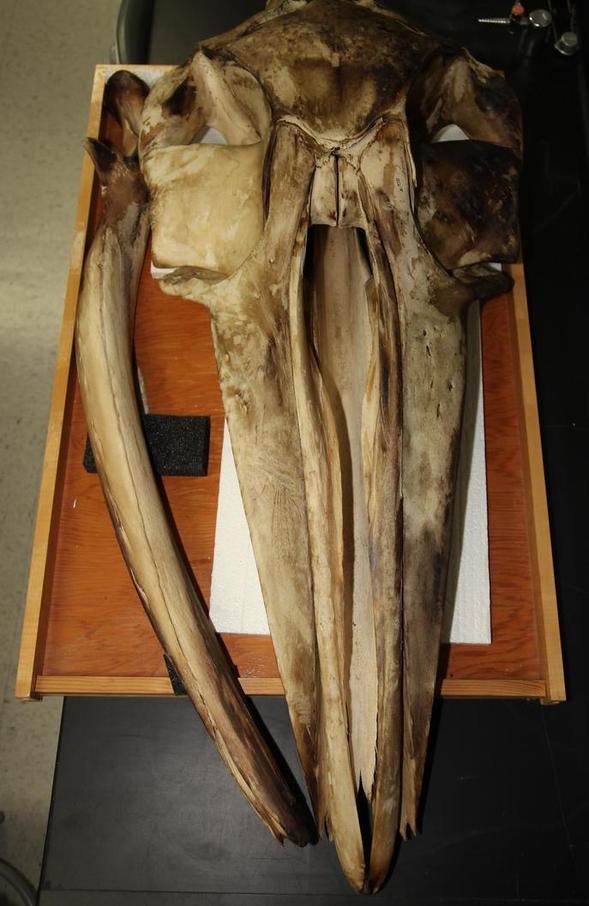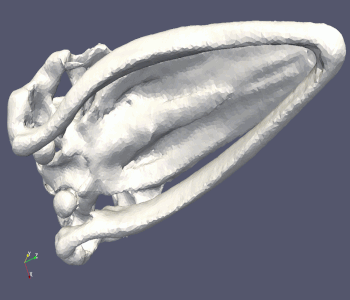Baleen Whales Hear Through Their Bones
Using a computer simulation of a fin whale head, scientists discovered the animal's skull amplifies and conducts low frequencies to their ear bones.

Understanding how baleen whales hear has posed a great mystery to marine mammal researchers. New research by San Diego State University biologist Ted W. Cranford and University of California, San Diego engineer Petr Krysl reveals that the skulls of at least some baleen whales, specifically fin whales in their study, have acoustic properties that capture the energy of low frequencies and direct it to their ear bones.
Baleen whales, also known as mysticetes, are the largest animals on earth, and include blue whales, minke whales, right whales, gray whales and fin whales. These whales can emit extremely low frequency vocalizations that travel extraordinary distances underwater. The wavelengths of these calls can be longer than the bodies of the whales themselves.
All of these whales are considered endangered, with the exception of the gray whale, which recently was removed from the endangered species list, Cranford said.
Over the past few years, government regulators have been attempting to enact laws placing limits on the amount of man-made noise that baleen whales can be exposed to. These man-made noises come primarily from three sources: commercial shipping, energy exploration, and military exercises.
According to Cranford, baleen whales might be particularly susceptible to negative effects from these sounds. Many of them produce vocalizations in the same frequency range as man-made noises, and too much man-made noise could limit the distance over which the whales are able to communicate about things like food and mates. Because low frequency sounds travel so far in the ocean, groups of whales that appear to be extremely far apart might indeed be within “hollerin’ distance,” as Cranford puts it.
3D modeling

A simulation of a fin whale skull deforming due to the vibrations of a 250 Hz sound wave. Note that the motion depicted in this animation has been magnified to make it easier to see. Image: Ted Cranford and Petr Krysl.
However, little information was available about how baleen whales actually hear for government regulators to base new legislation on. Most of what scientists know about how whales hear comes from inferring their frequency range from their own vocalizations, as well as anatomic studies of the ears and some sound playback experiments with whales in controlled environments. Cranford and Krysl wanted to take a different approach: build a highly complex three-dimensional computer model of a baleen whale head—including the skin, skull, eyes, ears, tongue, brain, muscles, and jaws—and then simulate how sound would travel through it.
In 2003, they got their opportunity when a young fin whale beached on Sunset Beach in Orange County, California. Despite intensive efforts to save the whale, it died. Cranford and Krysl were able to obtain the animal’s head for their research, placing it in an X-ray CT scanner originally designed for rocket motors.
Once they had their scan, the researchers employed a technique known as finite element modeling that breaks up data representing the skull and other parts of the head into millions of tiny elements and tracks their relationships with one another.
It’s a bit like dividing the whale's head into a series of LEGO bricks, Cranford explained, where the properties of the bone, muscle, and other materials determine how strong the connections are between the bricks. By simulating a sound wave passing through their computerized skull, they could see how each miniscule component of bone vibrates in response.
“At that point, computationally, it’s just a simple physics problem,” Cranford explained. “But it’s one that needs lots and lots of computational power. It can swamp most computers.”
Pressure or bone?
There are two ways sound can reach a whale’s tympanoperiotic complex (TPC), an “interlocking bony puzzle” of ear bones that is rigidly attached to the skull. One way is for the sound’s pressure waves to travel through the whale’s soft tissue to their TPC, but this becomes ineffective once sound waves are longer than the whale’s body, Cranford said.
The second way is for sounds to vibrate along the skull, a process known as bone conduction. Unlike pressure waves passing through soft tissue, longer waves lengths are amplified as they vibrate the skull.
When Cranford and Krysl modeled various wavelengths traveling through their computerized skull, they found that bone conduction was approximately four times more sensitive to low frequency sounds than the pressure mechanism. Importantly, their model predicts that for the lowest frequencies used by fin whales, 10 Hz – 130 Hz, bone conduction is up to 10 times more sensitive.
“Bone conduction is likely the predominant mechanism for hearing in fin whales and other baleen whales,” Cranford said. “This is, in my opinion, a grand discovery.”
Krysl added that we humans experience a version of this phenomenon, too.
“We have that experience when we submerge entirely in a pool,” he said. “Our ears are useless, but we still hear something because our head shakes under the pushing and pulling of the sound waves carried by the water.”
The researchers published their results today in the journal PLOS ONE. The fin whale skull used for their experiment now resides in SDSU’s Museum of Biodiversity.
Anatomy no accident
It’s possible these new findings will help legislators decide on limits to oceanic man-made noise, but Cranford stressed that what’s most important about their project is that they managed to solve a long-standing mystery about a highly inaccessible animal.
“What our contribution does is give us a window into how the world's largest animals hear, by an odd mechanism no less,” he said. “This research has driven home one beautiful principle: Anatomic structure is no accident. It is functional, and often beautifully designed in unanticipated ways.”
Cranford and Krysl have studied many species of toothed whales and beaked whales over the past 13 years, as well as dolphins. Their next step is to try to replicate the study for other species of baleen whales. The researchers will be reaching out to museums that house whale skulls.
“There is a blueprint for multiple species and it is useful to compare across species to gain insight,” Krysl explained.
The researchers’ work would not have been possible without support from the Office of Naval Research (Code 32), sponsored by Dr. Michael J. Weise; the Office of the Chief of Naval Operations, Environmental Readiness Division (OPNAV N45), sponsored through the Living Marine Resources program by Dr. Frank Stone and Dr. Robert Gisiner; and X-ray CT scanning was conducted at Hill Air Force Base in Clearfield, Utah, in the Non-Destructive Inspection Missile Support Group. The latter facility is the only one large enough in the world to produce the data needed for this study.



